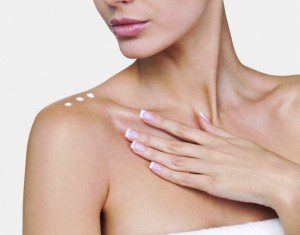Dr. Cyndi Yag-Howard explains the culprits and solutions.


Keeping your skin moisturized helps the skin maintain its flexibility and elasticity so that it can stand up to everyday trauma like bumps and cuts. Likewise, moisturizers help the skin maintain its integrity so that beneficial nutrients and medications are able to enter the skin, while harmful environmental factors like bacteria and fungus are not.
By knowing how our skin works, one can understand the detrimental effects of dry skin better. There are several layers to our skin. The outermost layer of our skin is called the stratrum corneum. It is arranged in a bricks-and-mortar structure. If one has healthy skin, the bricks of the stratum corneum are dead skin cells that originated as living cells in the deeper layers of the skin. As these cells die and break down, they become flat bricks of protein that contain natural moisturizing factor (NMF). NMF acts like a sponge to pull water into the skin, keeping it moist. These protein bricks also provide the skin with strength and a certain degree of protection from the damaging effects of sunlight’s ultraviolet radiation.
The “mortar” holds the skin’s “bricks” together and consists of fats (lipids) known as cholesterol, fatty acids and ceramides. These lipids surround the bricks to lock in the moisture and prevent water loss from the surface of the skin. They also provide an antimicrobial barrier to help prevent infection by the bacteria and fungi that exist in the environment. Therefore, it is important that the protein bricks and the fatty mortar work together properly for skin to stay moist, healthy and beautiful.
If your skin is healthy, you shed thousands of dead skin cells, called corneocytes, daily. These tiny, microscopic cells shed individually, making them virtually imperceptible to the human eye. However, if your skin is dry, the corneocytes don’t separate from each other like they should, and instead clump together, producing large flakes of skin that are plainly visible.
There are several reasons why skin becomes dry. First, as we age, our body’s ability to produce the proper lipids necessary for holding on to water in the skin’s surface decreases. Other factors that cause dry skin include sun exposure, which interferes with the skin’s ability to form NMF; soaps that dissolve the skin’s lipids and wash away the NMF; wind that blows water off the skin’s surface; and low temperature and humidity, both of which prevent the skin from being able to pull in water from the environment. Additionally, medical conditions like atopic dermatitis, xerosis, icthyosis and other less common genetic disorders predisposed people to dry, damaged skin.
There are two ways to increase the amount of water in the stratum. One is to pull more water into the skin’s surface and the other is sealing in the water that is already present so that it cannot escape or evaporate from the surface of the skin.
Skin care products that pull water into the stratum corneum contain ingredients called humectants. These products replace the skin’s NMF, which naturally depletes over time. Common humectants found in moisturizers include lactic acid, propylene glycol and urea. Another popular humectant, hyaluronic acid, has gained significant popularity in recent years because it is the major ingredient in fillers such as Restylane®, Perlane®, Juvederm® and Voluma®. It works by acting like a sponge to pull in water from the environment.
Skin care products that seal in the skin’s water are called emollients and occlusives. Emollients, such as lanolin, are fatty substances used to enhance the mortar between the protein bricks of the stratum corneum. Meanwhile, occlusives, such as mineral oil, dimethicone and petrolatum, are slippery and oily, leaving a film on the skin’s surface to prevent water loss.
Recent advancements in the understanding of skin moisturization place an emphasis on the skin’s lipid ratios and acid (pH) levels, which are optimized in order to imitate healthy skin. These prescription and non-prescription advanced moisturizers, known as barrier repair creams and lotions, along with soap-free barrier repair cleansers, help to preserve the skin’s natural brick and mortar structure.
In need of exfoliating away that dry skin? Try a product with salicylic acid, lactic acid, urea or retinol. Bothered by redness? Look for a moisturizer with niacin. Need antioxidant protection (we all do, by the way)? Seek moisturizers containing ascorbic acid (vitamin C), tocopheryl acetate (vitamin E), ferrulic acid and ubiquinone to provide protection from potentially damaging ultraviolet radiation and pollution.
Still have questions? Contact your dermatologist for guidance and understanding on which moisturizing options are best suited for your particular skin’s level of dryness and give it your best to incorporate that moisturizing option into your regular routine.
About Cyndi Yag-Howard, M.D, F.A.A.D: Dr. Yag-Howard is a board-certified dermatologist and dermatologic surgeon with specialized training and extensive experience in facial sculpting. She is a nationally recognized speaker on advanced surgical techniques for optimal surgical outcomes. She is active in many professional organizations holding leadership roles in the American Medical Association, the American Academy of Dermatology, the American Society of Dermatologic Surgery, the Women’s Dermatologic Society and Bikes for Tykes. Please visit www.yhderm.com for more information.
239.529.DERM
www.yhderm.com
 Southwest Florida's Health and Wellness Magazine Health and Wellness Articles
Southwest Florida's Health and Wellness Magazine Health and Wellness Articles
